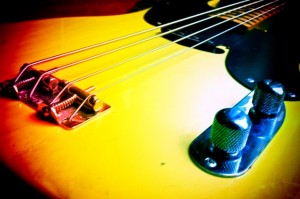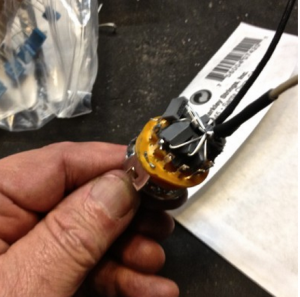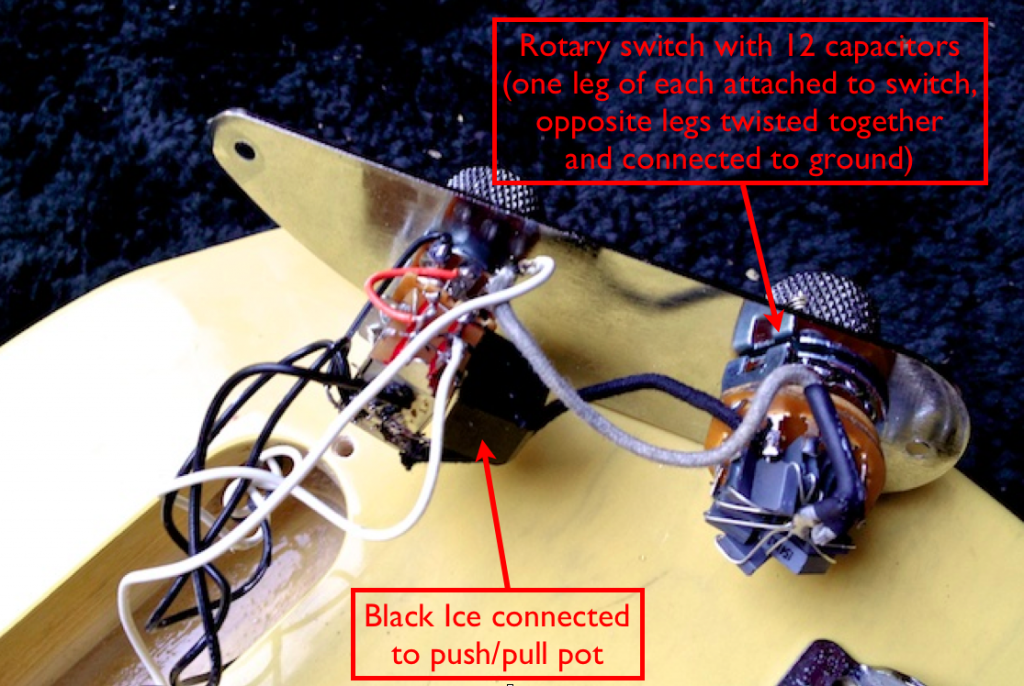After auditioning so many different tone-control schemes over the course of the Mongrel Strat Project, I wound up with more tone circuits than I have Strats, so I figured I’d victimize a bass — specifically, a 1954 Fender P-Bass reissue with a Seymour Duncan Quarter-Pound pickup, which I’ve written about here. It’s a minimalist one-pickup model with basic volume and tone controls.
I was eager to audition a multi-capacitor tone control like I wrote about here. (Actually, it’s literally the same tone control — the guitar where it used to reside now houses the Stellartone ToneStyler tone pot covered here.) And while I had the patient on the operating table, I figured I’d also install the Black Ice distortion cube I wrote about here. (My friends in the medical profession assure me that patients always appreciate it when surgeons indulge in improvisational operating-theater mods.)
Demo and details after the break:
(Hover your cursor over the little icons in the lower half of the waveform view for details about what you’re hearing in each portion of the demo.)
(FWIW, the light distortion on the first three phrases comes not from the bass’s electronics or an amp, but from overdriving a tape simulation plug-in I just bought: Universal Audio’s Studer emulation. I’ve been pouring it on everything like a six-year old with a squeeze bottle of ketchup. But the more extreme distortion in the last two phrases is from the Black Ice.)
I’m’a put a cap in your bass. First, let’s talk tone control. The original was your standard Fender-style circuit, with a 250k tone pot siphoning treble as you lower the knob. I replaced the pot with a rotary switch housing 12 different capacitors of ascending values, ranging from a teensy .001uF to a big-ass .15uF (the original cap was a .047, also known as a 473).
One option, of course, would have been to install a modern active tone control — a fine solution, but I wanted to retain the vintage/passive flavor of the instrument. But in the decade or so I’ve owned this bass, I doubt I’ve used the tone control more than once or twice. When I want a darker sound, I tend to EQ the amp or mix, because the simple passive treble bleed just sounds too flat and dull.
So what, you might ask, is the sonic difference between using multiple caps mounted on a rotary switch, and simply combining a pot and a single cap? After so many months of dicking around with self-indulgent experiments careful study, I believe I can actually answer the question!
Until I started experimenting with Vari-Tones and other multi-captone controls, I never realized how resonant the filter cutoff frequency is on these passive circuits. With a pot and a single cap, you cut highs. But as you switch from smaller to larger caps, you not only cut highs, but color the tone with varying frequencies of resonant “edge.” To my ear, both methods make your tone darker, but the latter is less likely to make it dull.
Twelve caps values is not as excessive it might seem. Once you start focusing on the aforementioned resonant edge, you find yourself thinking not only of filtering off highs, but of “tuning” the control to the key of the track. (BTW, the ToneStyler uses the same concept, but with 16 caps. It’s a superior solution — if you can spare a hundred bucks for a tone control.)
I’m not masochistic enough to record examples of all 12 settings, or sadistic enough to make you listen. So I just recorded the smallest (least treble reduction) cap, the largest (maximum cut), and one midway between.
Anyway, I now feel that a multi-cap switch usually beats a single-cap pot in a passive bass tone circuit. But if I were to do this again, I’d make a couple of changes: I’d add a switch setting with no cap whatsoever, and I’d go all the way up to a .47uF cap (474) for the option of an even darker sound.
Ice is nice. Regarding the Black Ice: As demoed in my previous post, it’s a cool (if limited) onboard distortion that requires no battery. I’d read online comments from other users saying they liked it even better in bass than guitar. I tend to agree. The fuzzy/farty tone just seems to work nicely in a passive bass circuit, and the fact that engaging the distortion makes the volume drop slightly bothers me less on bass than on guitar.
The manufacturer recommends installing the component with a dedicated control pot to regulate the strength of the effect, but I must respectfully disagree with that approach, especially when using lower-output pickups. The lower settings strike me as wimpy, and I prefer to control the drive via playing dynamics. (Also, when paired with a multi-pot tone control, you can reduce the distortion effect by selecting a darker tone. In the demo above, the Black Ice is engaged for the final two phrases. The lighter distortion of phrase 5 relative to phrase 4 is solely the result of changing the tone setting.)
Conclusion. I’m digging this all-passive mod. It expands the instrument’s range without compromising the bass’s retro sound or external appearance. You can buy clean, classy, prefab versions of the components, or make everything yourself for a few bucks if you don’t mind a little mess and duress. Speaking of which, here’s a peek inside the rat’s nest:











By the way, you can make a BlackIce for a fraction of the cost by getting a couple of small signal diodes from RadioShack. Try them wired up like the BlackIce, in opposite directions, or just try one.
Thanks, David. You are absolutely correct. I detailed this in my previous Back Ice post, including the specific types of diodes that yield the best results. If you’re handy with a soldering iron, you can do the mod for about a buck.
To compensate for the Black Ice’s volume drop, what if the wiring was set up to bypass the volume control when the Black Ice is activated? That way, you could set your amp so it’s loud enough with the Black Ice, then use the volume control to adjust the “clean” volume to balance.
I think that would totally work — if you’re cool with the tone you get from the bass with the volume rolled down. In minimal passive circuits like these, lowering the volume pot also introduces some some high-end loss. Not a good a or a bad thing — just a thing. 🙂
Gonna have to get back to learning how to solder , I have a miserable Squire P Bass and it would benefit from some serious mods like these ! Very cool stuff once again Joe :stupid:
Oh yeah, definitely worth burning a few fingertips to get back into soldering. The weakest link on Squiers are the pickups. You might be astonished by how much of an upgrade you can get just by changing that one component.
I wish I had the funds to buy a couple basses and do this to one of them. I’ve been really interested in the Varitone thing ever since I saw one on a Danelectro guitar a long time ago. This sounds like a humongous amount of tonal difference and upgrade from the original setup.
Speaking of the Varitone, I might as well ask; The original Orange Mk1 amps had what I think was called a FAC, which was a series of caps arranged in the preamp on a rotary switch. Matchless has an impedance cut knob on the higher-end (of an already high-end) amps, and Peavey came out with that Penta amp with a series of cap-based voices. Are we really talking about the same sorta circuitry, only mounted in the amp as opposed to in the instrument?
thanks!